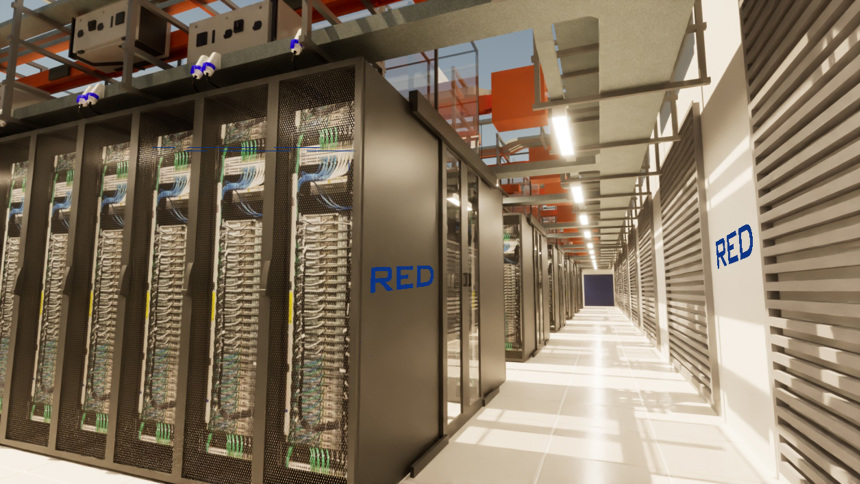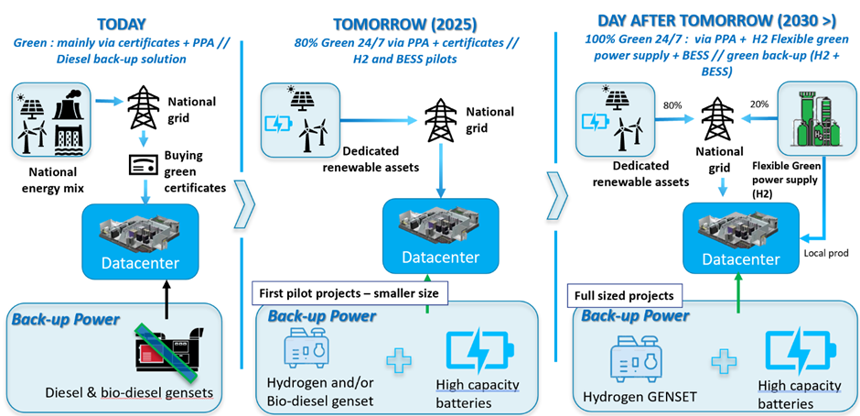
08 Jan 2024
15 minutes to read
THE ROADMAP TO ZERO CARBON AND WATER NEGATIVE DATA CENTRES
Key insights
- Next-gen data centre infrastructure is decentralised and resilient:
Microgrids and on-site generation reduce dependency on national grids, forming the backbone of sustainable, future-ready facilities. - Energy efficiency is maximised through cogeneration and thermal reuse:
Using combined heat and power and waste heat recovery, operators can optimise energy efficiency in data centres while supplying cooling and energy to nearby buildings. - Renewable resource data centres are becoming the standard:
By integrating data centres with renewable energy sources like solar, wind, and hydrogen, operators accelerate the transition to zero-carbon. - Smarter power protection strengthens reliability:
Designing a data centre with layered, fault-tolerant systems ensures uptime, while enabling participation in grid services for added value.
The Latest Generation Microgrid: Providing resilient, revenue-generating green power for data centres of the future
Decarbonising data centre energy consumption through smarter infrastructure
As the climate crisis rages on, there is an urgent need to decarbonise our data centres, whilst at the same time accommodating the huge projected increase in data transmission, processing and storage needed to feed the requirements of the modern world.
The classic scenario of connecting data centres to national electricity and water networks is becoming increasingly unsustainable. As a result, we now need to be looking towards microgrids or campus-scale utilities networks using decentralised and decarbonated generation. Firstly, to guarantee the resilience of utilities serving the data centre and secondly, future-proof the schemes that allow for the incorporation of zero-carbon generation, as new technologies and fuels come to market.
Not only will these new networks provide resilient and green services to the data centre, but will also be able to provide support to local networks and communities by providing waste heat, zero-carbon cooling and electricity to nearby consumers, as well as grid support services in the form of demand-side reduction and firm frequency response.
At RED Engineering, we specialise in designing data centre solutions that transform power protection plans from an operational overhead into a competitive advantage - helping operators build sustainable and future-ready facilities. Learn more about our approach to sustainable engineering and explore how we’re further supporting the transition to zero-carbon data centres on our Sustainability page.

Understanding microgrid components for data centre infrastructure
Microgrids are integrated utilities services networks, incorporating thermal and electrical distribution, cabling control and monitoring, water services, as well as urban support systems including lighting, security, and electric vehicle (EV) charging. These components are essential for designing a resilient and zero-carbon data centre infrastructure.
The scale of these networks can range from a single large data centre to a number of buildings on a single site, to a district-scale set-up where several different sites and buildings are connected.
The decentralised generation plant serving the network will be designed to be N+2, or whatever is stipulated by the Uptime Institute to achieve the necessary Tier rating. An energy centre located either on or adjacent to the site will usually contain all items of power, heat, and cooling generation to allow for ease of maintenance and operation control. The energy centre will also contain ancillary equipment such as circulation pumps and a water treatment plant.
One of the advantages of an integrated utilities microgrid is that it can be monitored, controlled, and coordinated using one centralised control system. This system will also provide details of overall system efficiency logged to date under different conditions and, with the implementation of AI and machine learning, will continuously work to improve energy efficiency in data centres.
Elements of a microgrid for data centre power protection plans
Microgrids play a critical role in providing the resilient, decentralised power that modern data centres demand. Covering everything from electrical distribution to battery and fuel cell storage, these systems are engineered to remove single points of failure and optimise uptime. This section examines the key elements that form the foundation of data centre power protection plans, ensuring continuous and efficient operation.
Electrical distribution systems
The electrical distribution system will need to be sized to allow for the total eventual load of the data centre, plus any potential power export connections planned in the future. Unless running in island mode, there will be a connection to the local electrical supply network as well as to the on-site generation plant.
The design of the electrical microgrid needs to be undertaken so that there are no single points of failure and so that the power supply can be maintained, even when there is a failure in one part of the system, or should the system need to be isolated for repair or maintenance.
The decentralised power generation plant should be designed for at least N+2 resilience so that even with one generator being out of service for maintenance, the failure of another will not affect the capacity of the generators to provide power under full load.
Integrating a renewable resource data centre into modern microgrid design
The energy centre will also contain other power supply sources, including batteries and possibly fuel cells for the conversion of hydrogen or other gas to electricity as a means of importing renewable energy into the system.
This brings into focus the new concept of N+k, where multiple renewable energy sources can be used together with electrical storage as the resilient back-up for part of the data centre’s power generation. These generation assets could be PV solar panels, wind turbines or other generators using biogas, biomass, energy from waste or other biofuels.
Data centre power protection plans and energy storage strategies
Red and parent company ENGIE have carried out studies on the effectiveness of the N+k concept, with the predicted results shown in the bar chart below:

Renewable energy sources such as solar farms or wind turbines can be used directly as a primary power source for data centres. This is in addition to potentially providing secondary power, by charging batteries or, via electrolysis, producing green hydrogen which can be stored and then converted back to electrical power in fuel cells.
An important part of the design process will be to provide the optimum mix between batteries and hydrogen storage/fuel cells. Based on the space available on site, operators must figure out the power and back-up period required to bring any stand-by generators on-line from a cold start.
The connection between the microgrid power distribution system and the main power grid will, in certain countries, enable us to provide grid flexibility services such as demand side reduction and firm frequency response, which, apart from providing a useful service to the main grid, can often be monetised to provide a useful source of additional income to the data centre.

Optimising energy efficiency in data centres through cogeneration
The use of cogeneration for the primary power supply to the data centre means the microgrid can operate at a much higher efficiency by using the heat off-take to supply absorption chillers, which in turn will provide cooling for the data centre.
Taking gas engines as an example, a 2 MWe generator would provide 2.2 MWth of heat from the cooling jacket and the exhaust stream. The temperature of the water from the jacket is around 80°C, and from the exhaust stream up to 400°C.
For gas turbines, the exhaust temperature is likely to be much higher (around 600°C). In both cases, steam can be supplied from the cogeneration (or CHP – combined heat and power) sets via waste heat boilers to two-stage absorption chillers, which provide a high-resilience source of chilled water for data centre cooling.
In general, with CHPs of the size we require, there will be an excess of heat generated as steam, and therefore, it is often beneficial to add a steam turbine to improve overall system efficiency. The absorption chillers operating at these higher steam temperatures would expect coefficients of performance (COPs) of at least 1.4
Future-ready fuels for energy efficiency in data centres
In the future, both gas engine as well as gas turbine generators will be able to accept an increasing blend of green fuels such as hydrogen, ammonia, biogas, and methanol with the ultimate aim of running on 100 per cent green fuels as supply chains develop. Gas turbines, in this respect, are far more flexible in accepting different fuels, and we believe that these will become the preferred choice for zero-carbon decentralised generation moving forward.
To explore this topic further, read our thought leadership blog : Enhancing Fuel Utilisation of Decentralised Microgrids, which looks at strategies to improve fuel efficiency and system integration.
Thermal distribution and waste heat utilisation
The generation of chilled water in the energy centre as described above will connect to the data centre using a high resilience flow and return distribution system, where there are no single points of failure and the chilled water supply can be maintained – even when there is a failure in one part of the system or if it has to be isolated for repair or maintenance – this includes dual chilled water flow and return connections into each building.
Such a new energy concept has turned out to be far more energy efficient than the current (whereby a data centre is only connected to the utility grid), drastically reducing the amount of net energy losses.
Another facet of the microgrid is its ability to export waste heat from the data centre site, which can then be used by industrial processes as well as commercial or residential buildings located nearby. This heat takes the form of excess energy from the power generation process as well as low-grade heat from data centre cooling systems.

Our research into Fifth Generation Heat Networks, Enhancing System-Level Efficiencies by Integrating Data Centre Waste Heat, explores how waste heat from data centres can be recovered and redistributed through advanced thermal networks to improve overall system efficiency.
Utilising thermal storage to optimise data centre energy consumption
When designing a data centre, the inclusion of thermal storage for both heating and cooling is key in order to reduce the peaks and troughs in demand, as well as being able to reduce the size of the cooling plant. Extensive modelling is required at the design stage in order to determine the optimum volume of storage required based on the demand variations across a 24-hour period.
For these cases, it is important that financial viability is tested by comparing the profiles of heat availability from the site and the heat demand profiles from the various consumers on the network.
For the data centre heat generation profile, the ideal customers would be industrial users of heat who will often have a steady, year-round high demand as part of their production processes. This model of continuous heat reuse is central to RED’s approach to sustainable data centre infrastructure, as outlined in our thought leadership article Transforming Data Centres into Eco-Friendly Hubs.
Depending on the main source of waste heat, if the waste heat network is low grade (generally around 30°C) then heat pumps will usually be required at the point where the waste heat network enters each building in order to raise the temperature to around 65OC, the usual level required in most buildings for domestic hot water and heating.
Developing renewable resource data centre infrastructure
The concept of an integrated utilities microgrid, where high-resilience heating, cooling and power is provided by an external services provider (and outsourced from the data centre itself) will be the most practical way for data centre operators and developers to:
- Reduce their reliance on national power grids to provide redundant power supplies
- Provide a structure to achieve their roadmap to carbon neutrality by progressively connecting new technologies and fuels as they come to market
- Allow external services companies to design, build, operate and fund the microgrid utilities distribution and generation
- Reduce the footprint of the data centre site
- Reduce CapEX and OpEX across the life of the installation.
To achieve optimum design in terms of renewable energy storage, distribution and life cycle analysis of the energy centre, financial modelling of this new concept is taking place using different design scenarios. This will bring to light any required investment during operational life, ensuring competitively low energy costs for data centre operators, as well as a steadily increasing trend toward that all-important zero-carbon goal.
Shaping the next phase of your data centre’s energy strategy
Work with RED Engineering to navigate the transition to zero-carbon data centre operations. Our comprehensive approach to data centre energy consumption, renewable resource integration, and data centre power protection plans ensures your facility will be prepared for tomorrow’s challenges while capitalising on today’s opportunities.
As part of this, our Sustainability and Decarbonisation Audit provides a structured review of your site’s environmental performance and net zero readiness - helping to identify quick wins, long-term opportunities, and the most effective strategies for reducing carbon emissions.
We also offer end-to-end data centre infrastructure consultancy, supporting projects from initial feasibility studies through to operational optimisation. For expert advice or general enquiries, contact our dedicated customer support team, who can connect you with the right specialist at RED Engineering.
Latest Insights
View all insights







